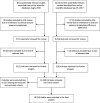A systematic review of adherence to oral pre-exposure prophylaxis for HIV - how can we improve uptake and adherence?
- PMID: 30445925
- PMCID: PMC6240194
- DOI: 10.1186/s12879-018-3463-4
A systematic review of adherence to oral pre-exposure prophylaxis for HIV - how can we improve uptake and adherence?
Abstract
Introduction: Oral pre-exposure prophylaxis (PrEP) is an effective strategy to reduce the risk of HIV transmission in high risk individuals. However, the effectiveness of oral pre-exposure prophylaxis is highly dependent on user adherence, which some previous trials have struggled to optimise particularly in low and middle income settings. This systematic review aims to ascertain the reasons for non-adherence to pre-exposure prophylaxis to guide future implementation.
Methods: We performed structured literature searches of online databases and conference archives between August 8, 2016 and September 16, 2017. In total, 18 prospective randomized control trials and implementation studies investigating oral pre-exposure prophylaxis were reviewed. A structured form was used for data extraction and findings summarized regarding efficacy, effectiveness, adherence and possible reasons for non-adherence.
Results: Adherence varied between differing populations both geographically and socioeconomically. Common reasons for non-adherence reported over multiple studies were; social factors such as stigma, low risk perception, low decision making power, an unacceptable dosing regimen, side effects, and the logistics of daily life. Oral pre-exposure prophylaxis with included antiviral regimens was not associated with a high risk of antiviral resistance development in the reviewed studies.
Conclusion: Our findings indicate that oral pre-exposure prophylaxis should be delivered within a holistic intervention, acknowledging the other needs of the targeted demographic in order to maximise acceptability. Socioeconomic factors and poor governmental policy remain major barriers to widespread implementation of pre-exposure prophylaxis.
Keywords: Antiviral drug resistance; HIV; HIV prevention; Medication adherence; Pre-exposure prophylaxis; Systematic review.
Conflict of interest statement
Authors’ information
Not applicable.
Ethics approval and consent to participate
Not Applicable.
Consent for publication
Not applicable.
Competing interests
The authors declare that they have no competing interests.
Publisher’s Note
Springer Nature remains neutral with regard to jurisdictional claims in published maps and institutional affiliations.
Figures



References
-
- UNAIDS. Global AIDS Update 2016. Geneva: UNAIDS; 2016.
-
- Joint United Nations Programme on HIV/AIDS . Prevention Gap Report. Geneva: Joint United Nations Programme on HIV/AIDS; 2016.
-
- Carroll A. State sponsored homophobia 2016: a world survey of sexual orientation laws: criminalisation, protection and recognition. 11. Geneva: International Lesbian, Gay, Bisexual, Trans and Intersex Association; 2016.
Publication types
MeSH terms
Substances
LinkOut - more resources
Full Text Sources
Medical
Miscellaneous

